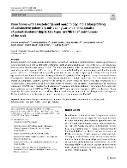Branchioma with a nested/organoid morphology: molecular profiling of a distinctive potentially misleading variant and reappraisal of potential relationship to CD34-positive/Rb1-deficient tumors of the neck

Author
Vanecek, Tomas
Grossman, Petr
Nikolov, Dimitar Hadzi
Vcelak, Radek
Zalud, Radim
Michal, Michal
Agaimy, Abbas
Publication date
2023Published in
Virchows ArchivVolume / Issue
483 (4)ISBN / ISSN
ISSN: 0945-6317Metadata
Show full item recordCollections
This publication has a published version with DOI 10.1007/s00428-023-03592-9
Abstract
Branchioma (previously called ectopic hamartomatous thymoma, branchial anlage mixed tumor, or thymic anlage tumor) is a rare lower neck lesion with an adult male predominance and an uncertain histogenesis. Except for 4 cases, all branchiomas described in the literature were benign. Recently, HRAS mutation was detected in one case, but still little is known about the molecular genetic background of this rare entity. We herein report the histological, immunohistochemical, and molecular genetic analysis of a branchioma with a nested/organoid (neuroendocrine-like) morphology in a 78-year-old man. Histology revealed classical branchioma areas merging with nested/organoid cellular component lacking conventional features of malignancy. Immunohistochemistry was positive for high-molecular-weight cytokeratins. CD34 was expressed in the spindle cell component. Moreover, the tumor cells showed near-complete loss of retinoblastoma (RB1) expression (<1% of cells positive). All neuroendocrine markers (synaptophysin, chromogranin, and INSM1) were negative. Next-generation sequencing (TSO500 Panel) revealed 5 pathogenic/likely pathogenic mutations including 1 mutation in KRAS and 2 different mutations in each of MSH6 and PTEN. FISH and DNA sequencing were negative for RB1 gene alterations. To our knowledge, this is the first report of a branchioma showing misleading nested/organoid morphology and the first report on Rb1 immunodeficiency in this entity, in addition to multiple gene mutations revealed by NGS.
Keywords
Branchioma, Ectopic hamartomatous thymoma, Neuroendocrine carcinoma-like, Head and neck, Retinoblastoma, RB1 gene, CD34, Androgen receptor,
Permanent link
https://hdl.handle.net/20.500.14178/2106License
Full text of this result is licensed under: Creative Commons Uveďte původ 4.0 International







